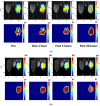pH Mapping of Skeletal Muscle by Chemical Exchange Saturation Transfer (CEST) Imaging
- PMID: 33291803
- PMCID: PMC7762073
- DOI: 10.3390/cells9122610
pH Mapping of Skeletal Muscle by Chemical Exchange Saturation Transfer (CEST) Imaging
Abstract
Magnetic resonance imaging (MRI) is extensively used in clinical and basic biomedical research. However, MRI detection of pH changes still poses a technical challenge. Chemical exchange saturation transfer (CEST) imaging is a possible solution to this problem. Using saturation transfer, alterations in the exchange rates between the solute and water protons because of small pH changes can be detected with greater sensitivity. In this study, we examined a fatigued skeletal muscle model in electrically stimulated mice. The measured CEST signal ratio was between 1.96 ppm and 2.6 ppm in the z-spectrum, and this was associated with pH values based on the ratio between the creatine (Cr) and the phosphocreatine (PCr). The CEST results demonstrated a significant contrast change at the electrical stimulation site. Moreover, the pH value was observed to decrease from 7.23 to 7.15 within 20 h after electrical stimulation. This pH decrease was verified by 31P magnetic resonance spectroscopy and behavioral tests, which showed a consistent variation over time.
Keywords: CEST; MRI; muscle; pH.
Conflict of interest statement
The authors declare no conflict of interest.
Figures









Similar articles
-
Chemical exchange saturation transfer imaging of creatine, phosphocreatine, and protein arginine residue in tissues.NMR Biomed. 2023 Jun;36(6):e4671. doi: 10.1002/nbm.4671. Epub 2022 Jan 3. NMR Biomed. 2023. PMID: 34978371 Free PMC article. Review.
-
Relaxation-compensated CEST-MRI at 7 T for mapping of creatine content and pH--preliminary application in human muscle tissue in vivo.NMR Biomed. 2015 Nov;28(11):1402-12. doi: 10.1002/nbm.3367. Epub 2015 Sep 16. NMR Biomed. 2015. PMID: 26374674
-
Creatine and phosphocreatine mapping of mouse skeletal muscle by a polynomial and Lorentzian line-shape fitting CEST method.Magn Reson Med. 2019 Jan;81(1):69-78. doi: 10.1002/mrm.27514. Epub 2018 Sep 23. Magn Reson Med. 2019. PMID: 30246265 Free PMC article.
-
Quantitative description of radiofrequency (RF) power-based ratiometric chemical exchange saturation transfer (CEST) pH imaging.NMR Biomed. 2015 May;28(5):555-65. doi: 10.1002/nbm.3284. Epub 2015 Mar 23. NMR Biomed. 2015. PMID: 25807919 Free PMC article.
-
A review of optimization and quantification techniques for chemical exchange saturation transfer MRI toward sensitive in vivo imaging.Contrast Media Mol Imaging. 2015 May-Jun;10(3):163-178. doi: 10.1002/cmmi.1628. Epub 2015 Jan 12. Contrast Media Mol Imaging. 2015. PMID: 25641791 Free PMC article. Review.
Cited by
-
31P ParaCEST: 31P MRI-CEST Imaging Based on the Formation of a Ternary Adduct between Inorganic Phosphate and Eu-DO3A.Inorg Chem. 2022 Dec 12;61(49):19663-19667. doi: 10.1021/acs.inorgchem.2c03329. Epub 2022 Nov 29. Inorg Chem. 2022. PMID: 36445702 Free PMC article.
-
Amide proton transfer-weighted magnetic resonance imaging for the diagnosis of symptomatic chronic intracranial artery stenosis: a feasibility study.Quant Imaging Med Surg. 2022 Nov;12(11):5184-5197. doi: 10.21037/qims-21-1063. Quant Imaging Med Surg. 2022. PMID: 36330191 Free PMC article.
-
Molecular signatures of disulfidptosis: interplay with programmed cell death pathways and therapeutic implications in oncology.Cell Mol Biol Lett. 2025 Jun 2;30(1):66. doi: 10.1186/s11658-025-00743-5. Cell Mol Biol Lett. 2025. PMID: 40457177 Free PMC article. Review.
-
Exploring the mechanism of rosmarinic acid in the treatment of lung adenocarcinoma based on bioinformatics methods and experimental validation.Discov Oncol. 2025 Jan 15;16(1):47. doi: 10.1007/s12672-025-01784-0. Discov Oncol. 2025. PMID: 39812944 Free PMC article.
-
Chemical exchange saturation transfer imaging of creatine, phosphocreatine, and protein arginine residue in tissues.NMR Biomed. 2023 Jun;36(6):e4671. doi: 10.1002/nbm.4671. Epub 2022 Jan 3. NMR Biomed. 2023. PMID: 34978371 Free PMC article. Review.
References
Publication types
MeSH terms
Substances
LinkOut - more resources
Full Text Sources
Medical

